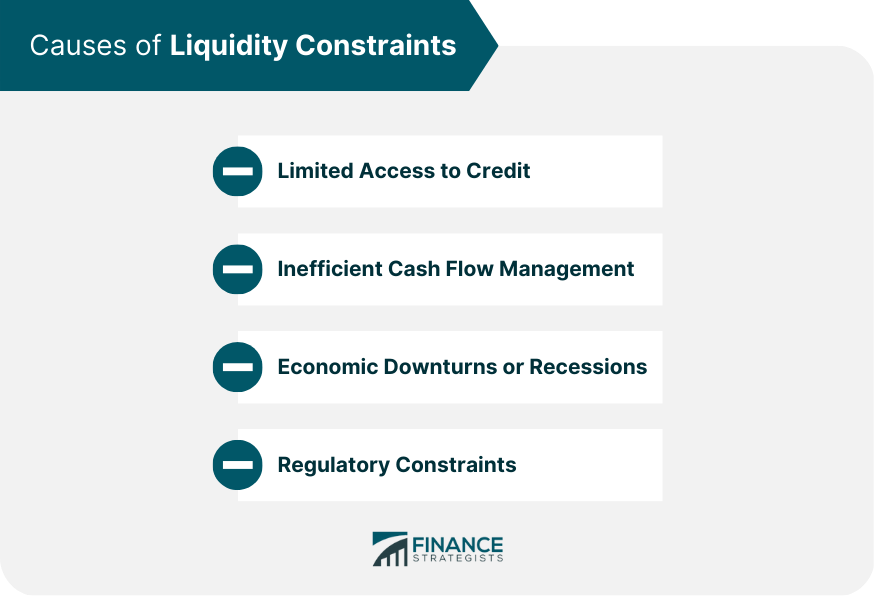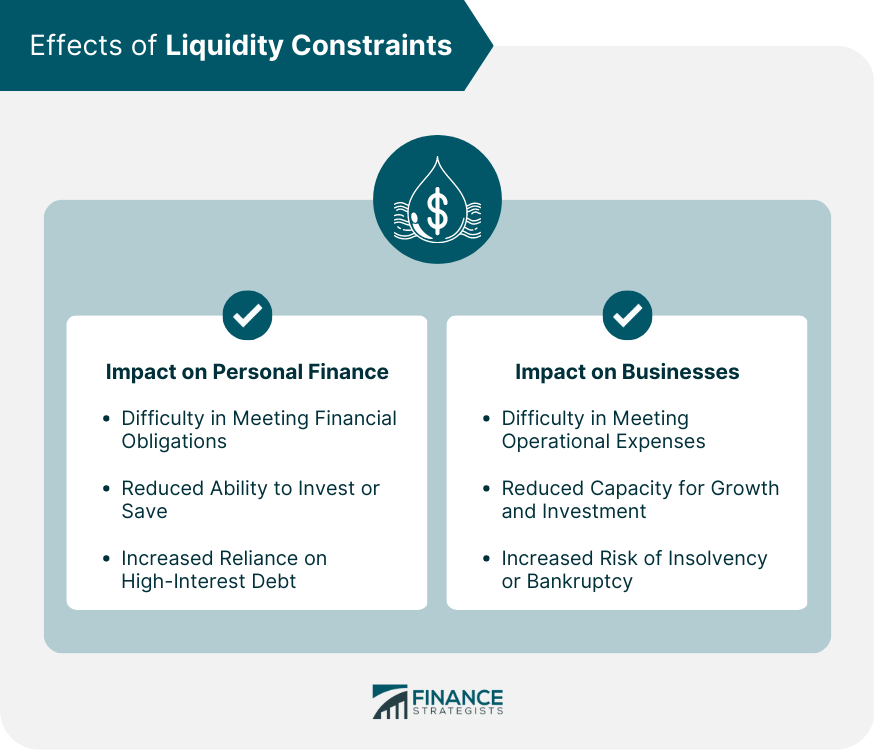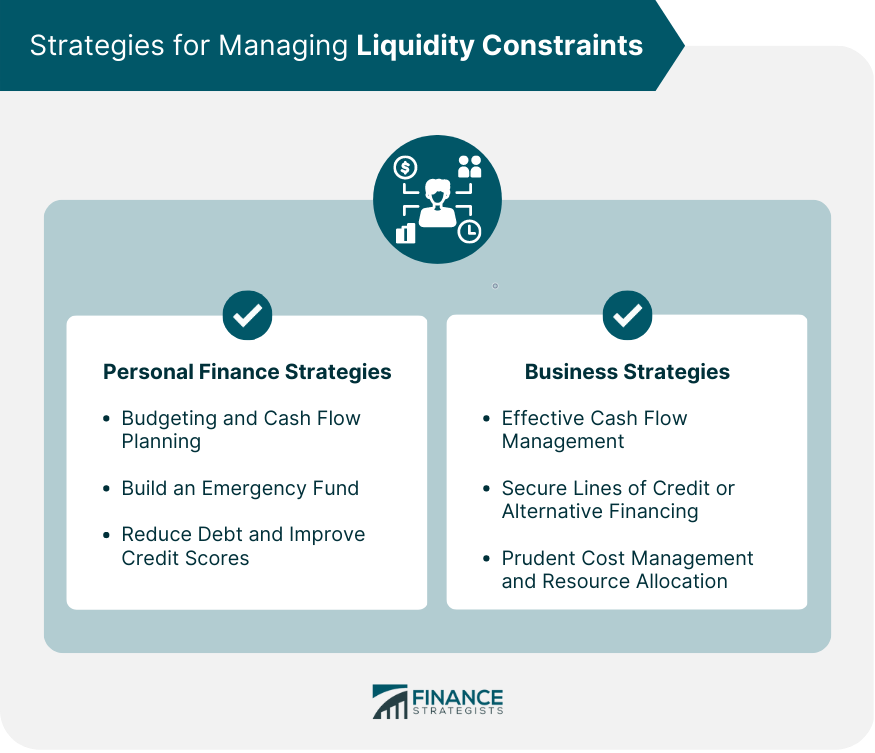Liquidity constraints refer to the limitations individuals or businesses face when trying to access funds or convert assets into cash. These constraints can hinder the ability to meet financial obligations, invest, or maintain cash reserves, ultimately affecting financial stability and growth. Understanding liquidity constraints is essential for both individuals and businesses, as it helps in managing financial resources more effectively. By being aware of potential constraints, individuals and businesses can better plan their finances, minimize risks, and optimize their strategies to achieve financial goals. One primary cause of liquidity constraints is limited access to credit, which can result from low credit scores, lack of credit history, or stringent lending criteria. This limited access can make it challenging for individuals and businesses to secure loans or other forms of credit, restricting their financial flexibility. Inefficient cash flow management, such as failing to collect receivables promptly or not controlling expenses, can lead to liquidity constraints. When cash inflows do not align with cash outflows, individuals and businesses may struggle to meet their financial obligations, leading to potential financial distress. Economic downturns or recessions can also contribute to liquidity constraints, as they often result in reduced consumer spending, lower business revenues, and increased unemployment. These factors can strain financial resources and make it difficult for individuals and businesses to maintain sufficient liquidity levels. Regulatory constraints, such as restrictions on capital movements or lending limits imposed by authorities, can contribute to liquidity constraints. These regulations may limit the availability of funds, affecting individuals' and businesses' ability to access credit or manage their financial resources effectively. Liquidity constraints can make it difficult for individuals to meet their financial obligations, such as paying bills, servicing debt, or addressing unexpected expenses. This difficulty can lead to financial stress, late fees, or even damage to credit scores. When individuals face liquidity constraints, their ability to invest or save for future financial goals is often limited. This reduced ability can hinder long-term financial planning, such as saving for retirement, funding education, or purchasing a home. Liquidity constraints may force individuals to rely on high-interest debt, such as credit cards or payday loans, to cover financial shortfalls. This reliance can lead to a cycle of debt, as interest payments further strain financial resources and exacerbate liquidity constraints. Liquidity constraints can make it challenging for businesses to meet operational expenses, such as payroll, rent, or inventory purchases. This difficulty can lead to delayed payments, reduced inventory levels, or even layoffs, negatively impacting the business's overall performance. When businesses face liquidity constraints, their capacity for growth and investment is often limited. This reduced capacity can hinder the ability to pursue new opportunities, invest in research and development, or expand into new markets, stunting the business's long-term growth potential. Liquidity constraints can increase the risk of insolvency or bankruptcy for businesses, as they struggle to meet their financial obligations. Insolvency can result in business closure, job losses, and significant financial losses for stakeholders, emphasizing the importance of addressing liquidity constraints proactively. Budgeting and cash flow planning are crucial strategies for individuals to manage liquidity constraints effectively. By creating a detailed budget and tracking income and expenses, individuals can gain a better understanding of their financial situation, identify areas for improvement, and prioritize their spending to ensure adequate liquidity. Establishing an emergency fund can help individuals mitigate the effects of liquidity constraints, as it provides a financial safety net for unexpected expenses. An emergency fund should typically cover three to six months' worth of living expenses, ensuring individuals have access to cash when needed without relying on high-interest debt. Reducing debt and improving credit scores can help individuals alleviate liquidity constraints by increasing their access to credit. By paying down high-interest debt, maintaining low credit utilization, and making timely payments, individuals can improve their credit scores and qualify for lower interest rates on loans and credit cards. Businesses can address liquidity constraints through effective cash flow management, including monitoring receivables and payables, optimizing inventory levels, and controlling expenses. Proper cash flow management helps businesses maintain adequate liquidity levels, ensuring they can meet financial obligations and invest in growth opportunities. Businesses can mitigate liquidity constraints by securing lines of credit or exploring alternative financing options, such as asset-based lending, invoice factoring, or crowdfunding. These financing options can provide businesses with access to capital when needed, enhancing their financial flexibility and ability to manage liquidity constraints. Prudent cost management and resource allocation are essential for businesses dealing with liquidity constraints. By carefully prioritizing expenses, investing in high-return projects, and streamlining operations, businesses can optimize their financial resources and alleviate the effects of liquidity constraints on their operations and growth. Central banks can use interest rate adjustments to influence liquidity constraints in the economy. Lowering interest rates can stimulate borrowing and spending, making it easier for individuals and businesses to access credit, while raising interest rates can reduce borrowing and encourage saving, potentially tightening liquidity conditions. Quantitative easing is another monetary policy tool used by central banks to address liquidity constraints. By purchasing large amounts of financial assets, central banks inject money into the economy, increasing the supply of credit and helping individuals and businesses access funds more easily. Governments can use tax incentives or relief measures to alleviate liquidity constraints for individuals and businesses. By reducing tax burdens or offering tax breaks for specific activities, such as investment or hiring, governments can free up financial resources and help individuals and businesses manage liquidity constraints more effectively. Government grants or subsidies can also be used to address liquidity constraints, particularly for businesses or industries facing financial challenges. These measures can provide direct financial support, helping businesses maintain operations, invest in growth, and navigate periods of economic uncertainty. Liquidity constraints play an essential role in economic models, as they help explain variations in consumer spending, saving behavior, and business investment. By incorporating liquidity constraints into these models, economists can better understand the factors that drive economic activity and design appropriate policy responses. Liquidity constraints can significantly influence consumer behavior, as they impact individuals' ability to spend, save, and borrow. When faced with liquidity constraints, consumers may cut back on discretionary spending, delay purchases, or rely more heavily on debt to finance their needs, affecting overall consumption patterns and economic growth. Liquidity constraints can have a substantial impact on economic growth, as they influence both consumer spending and business investment. When individuals and businesses face liquidity constraints, they are less likely to invest in new projects or make significant purchases, leading to reduced economic activity and potentially slowing economic growth. Liquidity constraints are significant in personal finance and business, as they can hinder individuals' and businesses' ability to meet financial obligations, invest in growth opportunities, and maintain financial stability. By understanding and proactively managing liquidity constraints, individuals and businesses can mitigate their effects and optimize their financial resources. Proactive management and planning are essential for individuals and businesses to mitigate the effects of liquidity constraints. Strategies such as budgeting, building emergency funds, reducing debt, and improving cash flow management can help address liquidity challenges and ensure financial resilience. Individuals and businesses facing liquidity constraints should consider seeking wealth management services to help them navigate these challenges.What Are Liquidity Constraints?
Causes of Liquidity Constraints

Limited Access to Credit
Inefficient Cash Flow Management
Economic Downturns or Recessions
Regulatory Constraints
Effects of Liquidity Constraints

Impact on Personal Finance
Difficulty in Meeting Financial Obligations
Reduced Ability to Invest or Save
Increased Reliance on High-Interest Debt
Impact on Businesses
Difficulty in Meeting Operational Expenses
Reduced Capacity for Growth and Investment
Increased Risk of Insolvency or Bankruptcy
Strategies for Managing Liquidity Constraints

Personal Finance Strategies
Budgeting and Cash Flow Planning
Building an Emergency Fund
Reducing Debt and Improving Credit Scores
Business Strategies
Effective Cash Flow Management
Securing Lines of Credit or Alternative Financing
Prudent Cost Management and Resource Allocation
Government and Regulatory Interventions
Monetary Policy Tools
Interest Rate Adjustments
Quantitative Easing
Fiscal Policy Tools
Tax Incentives or Relief
Government Grants or Subsidies
Liquidity Constraints and Economic Theory
Role of Liquidity Constraints in Economic Models
Relationship Between Liquidity Constraints and Consumer Behavior
Impact of Liquidity Constraints on Economic Growth
Final Thoughts
Liquidity Constraints FAQs
Liquidity constraints refer to limitations individuals or businesses face when trying to access funds or convert assets into cash. These constraints can hinder the ability to meet financial obligations, invest, or maintain cash reserves, ultimately affecting financial stability and growth for both individuals and businesses.
Common causes of liquidity constraints include limited access to credit, inefficient cash flow management, economic downturns or recessions, and regulatory constraints. These factors can restrict financial flexibility and make it difficult for individuals and businesses to access the funds they need.
Individuals can manage liquidity constraints in their personal finances by budgeting and cash flow planning, building an emergency fund, and reducing debt while improving credit scores. These strategies help individuals maintain financial stability and ensure they have access to funds when needed.
Businesses can mitigate the effects of liquidity constraints through effective cash flow management, securing lines of credit or alternative financing, and prudent cost management and resource allocation. These strategies help businesses maintain adequate liquidity levels and support their operational and growth objectives.
Government and regulatory interventions, such as monetary policy tools (e.g., interest rate adjustments and quantitative easing) and fiscal policy tools (e.g., tax incentives or relief and government grants or subsidies), can help alleviate liquidity constraints for individuals and businesses. These interventions can increase the availability of funds, improve access to credit, and stimulate economic activity.
True Tamplin is a published author, public speaker, CEO of UpDigital, and founder of Finance Strategists.
True is a Certified Educator in Personal Finance (CEPF®), author of The Handy Financial Ratios Guide, a member of the Society for Advancing Business Editing and Writing, contributes to his financial education site, Finance Strategists, and has spoken to various financial communities such as the CFA Institute, as well as university students like his Alma mater, Biola University, where he received a bachelor of science in business and data analytics.
To learn more about True, visit his personal website or view his author profiles on Amazon, Nasdaq and Forbes.











